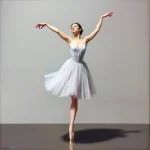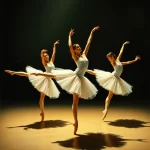Ballet: Chaconne (Christoph Willibald Gluck, 1976)

Introduction
Ballet: Chaconne, choreographed by George Balanchine to the music of Christoph Willibald Gluck, premiered in 1976. This ballet is a masterful blend of classical music and contemporary choreography, showcasing Balanchine’s innovative approach to dance. The ballet is set to the music from Gluck’s opera “Orfeo ed Euridice,” specifically the “Dance of the Blessed Spirits” and the “Chaconne.” The ballet does not follow a traditional narrative but instead focuses on the beauty and elegance of the dance itself, creating a visual and auditory feast for the audience.
Historical Background
Creation and Development
The creation of Ballet: Chaconne occurred during a period of significant artistic exploration and innovation in the world of ballet. The 1970s saw a resurgence of interest in classical music and dance, with choreographers like George Balanchine leading the charge. Balanchine, a co-founder of the New York City Ballet, was known for his ability to blend classical ballet techniques with modern sensibilities.
The inspiration for Ballet: Chaconne came from Gluck’s opera “Orfeo ed Euridice,” which is based on the Greek myth of Orpheus and Eurydice. The opera’s music, particularly the “Dance of the Blessed Spirits” and the “Chaconne,” provided a rich tapestry for Balanchine to weave his choreography. The collaboration between Balanchine and the New York City Ballet’s musicians was crucial in bringing this ballet to life.
Premiere and Reception
Ballet: Chaconne premiered on January 22, 1976, at the New York State Theater, Lincoln Center. The initial reception was overwhelmingly positive, with critics praising Balanchine’s innovative choreography and the seamless integration of Gluck’s music. The ballet quickly became a staple in the New York City Ballet’s repertoire, with notable early performances featuring some of the company’s most celebrated dancers.
Synopsis of the Ballet
Ballet: Chaconne is a one-act ballet that does not follow a traditional narrative structure. Instead, it is a series of dance sequences set to Gluck’s music, focusing on the beauty and elegance of the movements. The ballet opens with a serene and ethereal “Dance of the Blessed Spirits,” followed by the more structured and rhythmic “Chaconne.”
Key Moments or Scenes
- Opening Sequence: The ballet begins with a tranquil and graceful dance, setting the tone for the rest of the performance.
- Pas de Deux: A central duet that showcases the technical prowess and emotional connection between the lead dancers.
- Group Dances: The ensemble pieces highlight the harmony and synchronization of the corps de ballet.
- Finale: The ballet concludes with a grand and uplifting sequence, leaving the audience in awe of the dancers’ skill and artistry.
Musical Composition
Composer’s Role
Christoph Willibald Gluck, an 18th-century composer, was instrumental in reforming opera by emphasizing simplicity and emotional expression. His music for “Orfeo ed Euridice” is a prime example of this approach. The “Dance of the Blessed Spirits” and the “Chaconne” are notable for their lyrical beauty and structural clarity, providing an ideal foundation for Balanchine’s choreography.
Musical Themes and Motifs
The music of Ballet: Chaconne features recurring themes and motifs that enhance the narrative and emotional depth of the ballet. The “Dance of the Blessed Spirits” is characterized by its serene and flowing melodies, while the “Chaconne” is more rhythmic and structured. These contrasting musical elements create a dynamic and engaging auditory experience that complements the visual spectacle of the dance.
Famous Recordings and Performances
Several recordings of Gluck’s “Orfeo ed Euridice” include the “Dance of the Blessed Spirits” and the “Chaconne,” which have been performed by renowned orchestras and conductors. Notable performances of Ballet: Chaconne by the New York City Ballet have been recorded and are available for viewing, showcasing the ballet’s enduring appeal and artistic excellence.
Choreography and Dance
Choreographer’s Vision
George Balanchine’s vision for Ballet: Chaconne was to create a work that celebrated the beauty and elegance of classical ballet while incorporating modern elements. His choreography emphasizes clean lines, precise movements, and a seamless flow between sequences. Balanchine’s innovative approach to dance is evident in the way he uses the music to guide the choreography, creating a harmonious and captivating performance.
Signature Dance Numbers
- Pas de Deux: The central duet is a highlight of the ballet, showcasing the technical skill and emotional connection between the lead dancers.
- Group Dances: The ensemble pieces demonstrate the harmony and synchronization of the corps de ballet, creating a visually stunning display of movement.
- Solo Performances: Individual dancers have moments to shine, displaying their virtuosity and artistry.
Notable Interpretations
Over the years, different productions of Ballet: Chaconne have brought unique interpretations and adaptations to the choreography. Some productions have emphasized the classical elements, while others have incorporated more contemporary styles. These variations highlight the versatility and timelessness of Balanchine’s choreography.
Characters and Roles
Main Characters
As Ballet: Chaconne does not follow a traditional narrative, it does not have specific characters in the conventional sense. Instead, the focus is on the dancers and their movements, with the lead roles typically performed by principal dancers of the company.
Supporting Characters
The supporting roles are performed by the corps de ballet, who play a crucial role in creating the overall visual and emotional impact of the performance. Their synchronized movements and harmonious interactions with the lead dancers contribute to the ballet’s beauty and elegance.
Famous Dancers
Over the years, many renowned dancers have performed in Ballet: Chaconne, including principal dancers from the New York City Ballet. Some of the most notable performers include Suzanne Farrell, Peter Martins, and Merrill Ashley, whose interpretations have left a lasting impact on audiences and critics alike.
Cultural and Artistic Impact
Influence on Ballet and Dance
Ballet: Chaconne has had a significant influence on the world of ballet and dance. Balanchine’s innovative choreography and use of classical music have inspired countless choreographers and dancers. The ballet’s emphasis on elegance, precision, and emotional expression has become a hallmark of Balanchine’s style and has influenced the development of contemporary ballet.
Cultural Significance
Ballet: Chaconne holds a special place in popular culture and the arts. Its timeless beauty and artistic excellence have made it a favorite among ballet enthusiasts and a staple in the repertoire of major ballet companies. The ballet has also been featured in various media, including film and television, further cementing its cultural significance.
Legacy and Revivals
Since its premiere, Ballet: Chaconne has been revived numerous times by the New York City Ballet and other major ballet companies around the world. These revivals have kept the ballet alive and relevant, allowing new generations of dancers and audiences to experience its beauty and artistry. The ballet’s enduring popularity is a testament to its timeless appeal and Balanchine’s genius.
Iconic Productions
Historic Productions
Some of the most famous historical productions of Ballet: Chaconne include its original 1976 premiere by the New York City Ballet, featuring Suzanne Farrell and Peter Martins. This production set the standard for future performances and showcased Balanchine’s innovative choreography and Gluck’s beautiful music.
Contemporary Productions
Recent productions of Ballet: Chaconne have continued to captivate audiences with their fresh interpretations and modern sensibilities. These contemporary performances often incorporate new elements in set, costume, and lighting design, while staying true to Balanchine’s original vision. Notable recent productions include those by the New York City Ballet and other major ballet companies around the world.
Production Design
The set, costume, and lighting design play a crucial role in creating the overall atmosphere and visual impact of Ballet: Chaconne. Traditional productions often feature elegant and minimalist designs that highlight the dancers and their movements. Contemporary productions may incorporate more elaborate and innovative designs, adding new dimensions to the performance.
Critical Reception and Reviews
Initial Critical Response
The initial critical response to Ballet: Chaconne was overwhelmingly positive. Critics praised Balanchine’s innovative choreography and the seamless integration of Gluck’s music. The ballet was lauded for its elegance, precision, and emotional depth, quickly becoming a favorite among audiences and critics alike.
Modern Reviews
Contemporary critics continue to hold Ballet: Chaconne in high regard, often highlighting its timeless beauty and artistic excellence. The ballet remains a staple in the repertoire of major ballet companies, with modern audiences appreciating its elegance and emotional resonance. The enduring popularity of Ballet: Chaconne is a testament to its significance in the world of dance.
Fun Facts and Trivia
Behind-the-Scenes Stories
One interesting behind-the-scenes story involves the collaboration between Balanchine and the New York City Ballet’s musicians. Balanchine was known for his meticulous attention to detail, often working closely with the musicians to ensure that the choreography and music were perfectly synchronized.
Notable Performers
Over the years, many famous dancers have performed in Ballet: Chaconne, including Suzanne Farrell, Peter Martins, and Merrill Ashley. These dancers have left a lasting impact on the ballet, with their performances often cited as some of the best in the history of the production.
Trivia
- Ballet: Chaconne was one of the last ballets choreographed by George Balanchine before his death in 1983.
- The ballet’s music, composed by Christoph Willibald Gluck, is taken from his opera “Orfeo ed Euridice.”
- The “Chaconne” is a type of musical composition characterized by a repeating bass line and variations in melody and harmony.
Conclusion
Summary of the Ballet’s Importance
Ballet: Chaconne is a significant work in the world of dance, showcasing George Balanchine’s innovative choreography and Christoph Willibald Gluck’s beautiful music. The ballet’s emphasis on elegance, precision, and emotional expression has made it a favorite among audiences and critics alike, influencing countless choreographers and dancers.
Final Thoughts
Ballet: Chaconne is a timeless masterpiece that continues to captivate audiences with its beauty and artistry. Whether you are a seasoned ballet enthusiast or a newcomer to the world of dance, this ballet offers a unique and unforgettable experience. I encourage readers to watch a performance or listen to the score to fully appreciate the genius of Balanchine and Gluck.
FAQ
What is the central theme of this ballet?
The central theme of Ballet: Chaconne is the celebration of beauty and elegance in dance, without following a traditional narrative structure.
Who are the main characters in this ballet?
As Ballet: Chaconne does not follow a traditional narrative, it does not have specific characters. The focus is on the dancers and their movements.
What is the most famous dance number in this ballet?
The Pas de Deux is one of the most famous dance numbers in Ballet: Chaconne, showcasing the technical skill and emotional connection between the lead dancers.
How long does a typical performance of this ballet last?
A typical performance of Ballet: Chaconne lasts approximately 30 minutes.
Are there any modern adaptations of this ballet?
Yes, there have been several modern adaptations of Ballet: Chaconne, incorporating new elements in set, costume, and lighting design while staying true to Balanchine’s original vision.
Why is this ballet considered important in the history of dance?
Ballet: Chaconne is considered important in the history of dance due to its innovative choreography by George Balanchine and its seamless integration of Christoph Willibald Gluck’s music. The ballet has influenced countless choreographers and dancers, contributing to the development of contemporary ballet.





